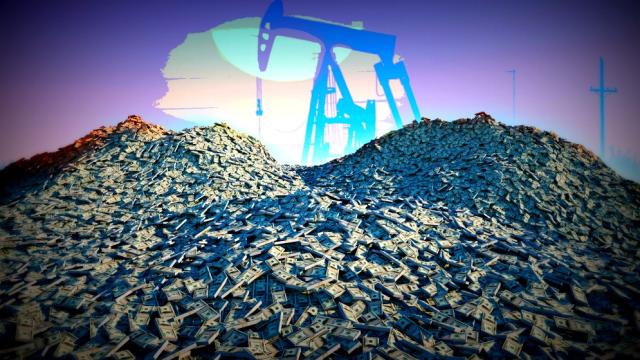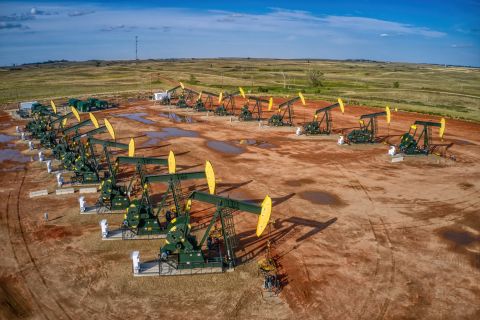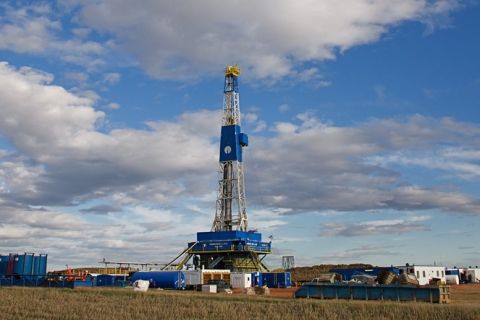
The recent volatility in crude oil prices means that lenders, private-equity firms and investment funds are keeping a close eye on existing loans taken out by energy companies. (Source: Hart Energy/Shutterstock.com)
The number of bankruptcies filed by overleveraged energy companies declined in the past two years, but debt levels still remain high, according to a recent report by law firm Haynes and Boone.
While some oil and gas producers have restructured their debt to avoid filing, others have not fared so well. In 2018, 29 exploration and production companies filed for bankruptcy, a slight uptick from the 24 E&P bankruptcy filings a year before, the Haynes and Boone report said. The highest group of bankruptcies hit the oil and gas industry in 2015 and 2016 when more than 100 E&Ps filed for Chapter 11.

As for the New Year, the outlook remains murky after crude oil prices took a hit in the fourth quarter dropping by 30% during October.
“It remains to be seen what happens in 2019,” said Kelli Norfleet, a Haynes and Boone partner in the restructuring practice group. “It depends a lot on whether these companies and their production are hedged. Those who are hedged are insulated from the recent drop in prices, otherwise, companies will see their revenue impacted significantly.”
However, the recent volatility in crude oil prices means that lenders, private-equity firms and investment funds are keeping a close eye on existing loans taken out by companies across the energy sector who are facing an uncertain future if commodity prices dip again.
‘Leaner, Meaner’
In late 2014, oil companies faced headwinds when crude oil prices plummeted to $30 a barrel from over $100, forcing many of them to file for bankruptcy the following year. These overleveraged energy companies had relied solely on higher crude oil prices to bail them out of extremely high debt loads of several billion dollars and could no longer meet their debt service payments even as they slashed costs.
“Drilling companies have become much more efficient in the current cycle while banks who lend to the E&P sector are more cautious than in the past,” said Bernard Weinstein, a business economist at Southern Methodist University (SMU). “It’s not surprising that the number of bankruptcies is much lower today than it was a few years ago, the last time we saw a significant drop in oil prices.”
The low oil prices hit the energy industry hard as a total of 167 producers since 2015 were forced to file for bankruptcy while creditors received only a small fraction of their investment. These bankruptcies involve $96 billion in cumulative secured and unsecured debt through the end of 2018.
The trend has not abated even though oil prices have steadily rebounded since 2016 while hitting some slumps. While the number of filings has slowed down, the total amount of debt remains stag-gering—the amount of debt administered in 2018 was $13.3 billion, surpassing the $8.5 billion ad-ministered in 2017.
Oil and gas firms have become “leaner, meaner and more self-sufficient,” said Ethan Bellamy, a managing director who covers energy stocks at Baird, a Milwaukee-based investment bank. “We haven't seen excessively generous oil prices since 2014, so we now have had five years of fat cutting, capital discipline and efficiency gains under our belts. The survivors by definition have much more resilient and economic footprints and business models.”
Although private equity is flush with capital, public equity is undergoing massive belt-tightening as investors demand free cash flow, buybacks, dividends and returns on investment, Bellamy said.
“The leveling off is certainly welcome, but I see two areas of continued concern for 2019—non-Permian players and the oilfield services sector,” said Bruce Bullock, director of the Maguire Energy Institute at SMU's Cox School of Business in Dallas.
While a number of non-Permian plays remain economic at current prices, there continues to be a dearth of capital flowing into these other basins, Bullock said.
“Companies focused strictly outside of the Permian will still be challenged,” he said.
OFS, Midstream Outlook
As for the oilfield services, a large majority of the sector includes smaller micro- or small-capitalization firms, which Bullock said institutional investors tend to shun.
“When you get below the top 10 oilfield services sector companies, this industry remains very fragmented and unconsolidated,” he said. “Prolonged prices in the $50 range will challenge these firms and consolidation, liquidation or bankruptcy will continue among the smaller companies in this segment.”
There have been 175 oilfield services bankruptcies from 2015 to 2018 with a total amount of debt of $57.4 billion, according to the Haynes and Boone report. While the number of oilfield services bankruptcies fell in 2018 to 12 filings with a total of $3.85 billion in debt vs. 40 filings with $35 billion debt in 2017, some factors are leading to a potential downturn in the sector.
Haynes and Boone partner Norfleet said she expects the rate of bankruptcies for oilfield services companies to remain fairly low as the effect of oil prices on them is usually more delayed. As for midstream companies, she said the midstream sector has been “fairly insulated from the downturn” in oil prices because there is demand for their infrastructure.
The midstream sector also reported fewer bankruptcies last year. Only two Chapter 11 bankruptcies were filed by midstream companies through the end of 2018. Overall, a total of 25 midstream companies filed for bankruptcy since 2015 with $20.4 billion in cumulative secured and unsecured debt.
Cautious Time For Energy
Norfleet said energy companies have learned to tighten their purse strings by restructuring their debt and lowering their leverage. Others have followed another strategy of selling off either core or noncore assets, raising equity financing or seeking debt financing from the markets to bolster their liquidity. Some companies were able to refinance their distressed unsecured debt to secured debt or second lien and extend the maturities, she said.
E&P companies will continue to face headwinds as long as crude oil prices remain in the $50 range. If crude oil prices reach the $60 level for an extended period, it would improve the balance sheets of many E&P companies, Norfleet said.
Wellhead prices for natural gas remain “anemic” and are not likely to increase, the Haynes and Boone report said. Several public companies announced significant reductions in their 2019 exploration and production budgets, which can be a sign of a slowdown and more risk to their balance sheets.
“This continues to be a cautious time for energy companies,” she said. “Challenges will remain with E&P companies with prices remaining low. People were optimistic that prices would rise at the beginning of the year, but they have dropped off again.”
The spring redetermination period will be “interesting” to watch this year as the borrowing bases will be reset for the first time since oil prices began to decline in October, Norfleet said.
When bankers evaluate the value of the oil and gas reserves, it depends on crude oil prices, she said. If prices remain range-bound in the $50s, the reserves will be valued lower and the borrowing base will be adjusted downward.
This could hamper the exploration and drilling activity of some companies if the value of their collateral declines. It could also trigger a pay down requirement, forcing companies to pay the difference to meet lower borrowing bases.
Norfleet said companies facing a pay-down requirement with strained liquidity could default under their credit facilities, as many companies did during the previous price decline in 2015 and 2016. Companies will be less liquid as their revenue declines and management will have to either sell off assets or lower their costs by reducing the number of employees.
“In a depressed price environment, companies won’t get as much value for their assets,” Norfleet said.
Overall, oil prices will play a large factor this year in the future of some energy companies.
“The general sense is that people are watching and waiting to see what prices do,” she said. “Any increase in the price of crude oil is going to help the revenue of these companies who may be facing liquidity problems. 2019 could be an interesting year for the oil and gas industry.”
Recommended Reading
Analysts: Diamondback-Endeavor Deal Creates New Permian Super Independent
2024-02-12 - The tie-up between Diamondback Energy and Endeavor Energy—two of the Permian’s top oil producers—is expected to create a new “super-independent” E&P with a market value north of $50 billion.
Is Grayson Mill the Next Bakken Domino to Fall After Chevron-Hess?
2024-01-31 - As E&Ps look to bulk up outside of the Permian Basin, EnCap-backed Bakken player Grayson Mill Energy is reportedly exploring a sale valued around $5 billion.
Diamondback Energy to Acquire Permian’s Endeavor for $26B
2024-02-11 - Diamondback Energy will acquire Endeavor Energy in a cash-and-stock agreement that will create a Permian juggernaut with a combined value of more than $52 billion in a merger of near equals.
Williston Warriors: Enerplus’ Long Bakken Run Ends in $4B Chord Deal
2024-02-22 - Chord Energy and Enerplus are combining to create an $11 billion Williston Basin operator. The deal ends a long run in the Bakken for Enerplus, which bet on the emerging horizontal shale play in Montana nearly two decades ago.
Sold in 66 Days: Inside the Diamondback-Endeavor Deal
2024-03-26 - Diamondback Chairman and CEO Travis Stice first offered “at least $25 billion” for Endeavor Energy Resources on Dec. 8. The deal closed just weeks later for $26 billion.






